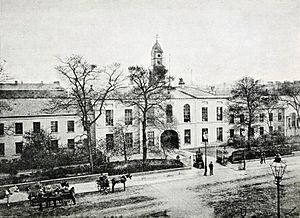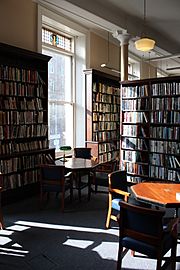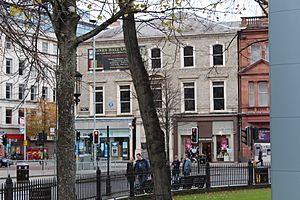Linen Hall Library facts for kids
Quick facts for kids Linen Hall Library |
|
|---|---|
 |
|
| General information | |
| Type | Subscription library |
| Location | Belfast, Northern Ireland |
| Coordinates | 54°35′50.60″N 05°55′53.53″W / 54.5973889°N 5.9315361°W |
The Linen Hall Library is a very old and special library in Belfast, Northern Ireland. You can find it at 17 Donegall Square North. It is the oldest library in Belfast. It is also the last "subscribing library" in Northern Ireland. This means people used to pay a fee to become members and borrow books. The library is a key part of Belfast's cultural life. It is an independent organization that works for good causes.
Contents
Discovering the Library's Past
How the Library Began

The Linen Hall Library has a unique story. It was started in 1788 by a group of skilled workers. They called it the Belfast Reading Society. In 1792, its name changed to the Belfast Society for Promoting Knowledge. In 1795, they decided to build a large library. They also wanted to collect tools for science and items from nature and art. Their goal was to help people learn and explore new ideas.
The society began collecting books. They focused on books about Ireland. For example, they published Ancient Irish Music in 1796. They also collected other items to help people learn. However, the society faced challenges in the late 1790s. They did not have their own building. They also struggled with efforts to control new ideas. Despite these problems, the library survived. This was thanks to the efforts of Rev. William Bruce.
Moving to a New Home
In 1802, the Library moved into its own building. This was the White Linen Hall. The library got its name from this building. Even today, its official name is still the Belfast Society for Promoting Knowledge. The library had a tough time for most of the 1800s. It became more traditional. It even debated whether to include fiction books.
As the library's 100th birthday neared, it faced another challenge. It lost its home in White Linen Hall. This was because the new Belfast City Hall was going to be built there. The library then moved into a warehouse. This building was in Donegall Square. It was designed by Charles Lanyon. The library still uses this building today. At this time, the library also changed. It became a public service. It took on the duty of caring for its collections for everyone. The library also became more ambitious. It started collecting books with new energy. It also began many cultural programs.
Challenges and Revival
The library continued to do well between the two World Wars. This was because public libraries were still developing slowly. Even after World War II, it was a center for creativity in Northern Ireland. However, it later faced difficulties. Public libraries received more funding. Also, there were many bombings in the city center. These events caused fewer people to visit the library.
By the late 1970s, the library was almost closing. It had many important materials. This included a large collection about a period of conflict in Northern Ireland. But its building was in poor condition. It had few users and serious money problems. The Department of Education threatened to stop its funding. In 1980, there were plans to close the library for good.
Saving the Library and Growing Stronger
After 1980, a big effort began to save the library. It was decided that the library should allow free public access. It also decided to focus on Irish studies, politics, and culture. This was because it already had strong collections in these areas. This also helped it avoid competing with Belfast Central Library. This new plan worked well. More people became members. The library also became a bigger cultural center. It helped with research and built strong ties with the community.
Soon, it became clear that the library needed more space. After ten years of looking at different options, a decision was made. In 1996, the library bought a very long lease for the upper floors of a nearby building. Then, a big fundraising campaign started. This was to pay for developing the new space. Construction began in 1999. The new areas opened on September 16, 2000.
On October 27, 2016, the library welcomed a special guest. The President of Ireland, Michael D. Higgins, visited for the first time. President Higgins is a poet himself. He was very interested in the library's resources about local poet Sir Samuel Ferguson. A choir of students from Holy Cross Boys' Primary School and Campbell College performed for the event.
What You Can Find at the Library
The Linen Hall Library offers many services. It provides a free public reference service. This means anyone can visit and use its materials. It also has a general lending service for adults and children. This allows members to borrow books.
The library also has several special collections. It is the main center for "Irish and Local Studies" in Northern Ireland. This includes many old books, magazines, and newspapers from Belfast and Ulster. Some of these date back to 1738. It also has many old documents and handwritten materials. You can find a large collection of maps there, some of which are very old and important. The library also has many materials in the Irish language.
Its "Northern Ireland Political Collection" is very important. It has been collected since 1968. It contains 250,000 items. This collection is the main record of the recent period of conflict. It includes materials that show all sides of the events. The library also has collections about family history (genealogy). It has items about the poet Robert Burns. It also collects materials on performing arts in Northern Ireland.
Northern Ireland does not have a single "national library." So, the Linen Hall Library helps collect all books and journals published in Northern Ireland since 2000. This collection is called NIPR (National Collection of Northern Ireland Publications). This collection is shared between the Linen Hall Library and Belfast Central Library.



